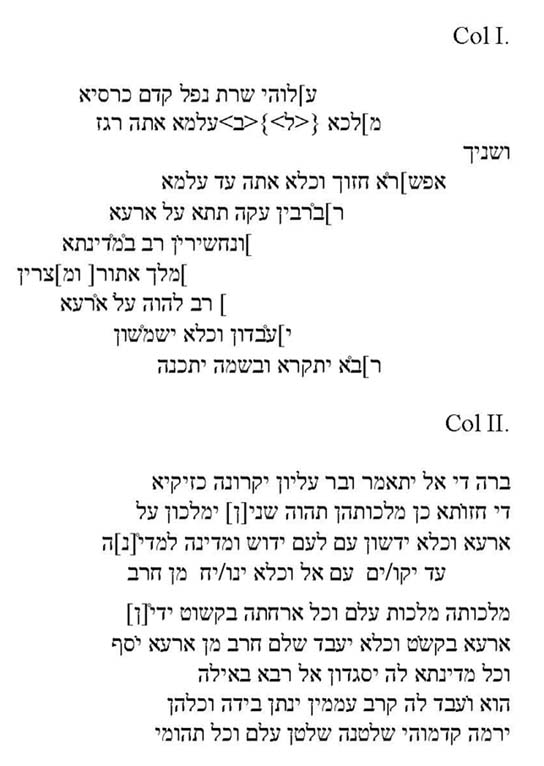Transcription of 4Q246

Translation of 4Q246
Col. I
1. [ ] rested upon him, he fell befor the throne
2. [… k]ing, rage is coming to the world, and your years
3. […]. . . your vision, all of it is about to come unto the world.
4. [… mi]ghty [signs], distress is coming uopn the land
5. […] great slaughter in the provinces
6. […] king of Assyria [ and E]gypt
7. […] he will rule over the land
8. […] will do and all will serve
9. [… gr]eat will be called and he will be designated by his name.
Col II
1. He will be called the Son of God, and they will call him the Son of the Most High like a shooting star.
2. that you saw, so will be thier kingdom, they will rule several years over
3. the earth and crush everything, a people will crush another people and nation (will crush) nation.
4. Blank (space left balnk in the manuscript) Until the people of God arises and makes everyone rest from warfare.
5. Their kingdom will be an eteranl kingdom, and their paths will be righteous. They will judge
6. the earth with truth, and all (nations) will make peace. The warfare will cease from the land,
7. and all (nations) will worship him. The great God will be their help,
8. He Himself will fight for them, putting peoples into their power, all of them
9. He will cast them away before him, His dominion will be an everlasting dominion and all the abysses
The main question of 4Q246 (Aramaic Apocalypse) is the personage designated the “Son of God.” Who is the “Son of God”? Is this a positive figure or a negative figure? J. T. Milik insists that the “Son of God” refers to a Seleucid king, referring Antiochus IV Epiphanes (Milik 1992, 383). Florentino Garcia Martinez suggests that it is an angelic savior as Michael, Melchizedek, and the Prince of Light (Martinez 1992, 162-79). Most scholars view the figure as a messianic redeemer who will overthrow God’s enemies and establish the kingdom of God’s people (Cross 1996, 1-13). But Joseph A. Fitzmyer argues that the reference of the Son of God is not a messiah, but a coming Jewish ruler, perhaps a member of the Hasmonean dynasty (Fitzmyer 1993, 173-74). According to the scholars, therefore, the title “Son of God” would be either a heavenly figue or a human being.
Martin Hengel suggests that the figure is similar to “the one like a Son of Man” in Daniel 7:13-14 (Hengel 1976, 45), and argues that the tiles may be interpreted collectively “of the Jewish people.” I also argue that the author of 4Q246 was influenced by Daniel 7. The two texts reveal such an extensive degree of verbal, thematic, and structural correspondence. The most striking parallels between the two texts are the two phrases שלטנה שלטן עלם (“whose dominion is an everlasting dominion” [Dan 7:14; cf. 4Q246 2:9]) and מלכותה מלכות עלם (“his/its kingdom will be an everlasting kingdom” [Dan 7:27; cf. 4Q246 2:5]). Karl A. Kuhn argues that the verb דוש (crush) supplements these two verbal correspondences (Dan 7:23; 4Q246 2:3) in terms of the thematic parallels (Kuhn 2007, 28). In addition to these parallels, Kuhn suggests that the two texts present a transition of the dominion from the beasts/provinces to an individual figure/the people of God:
1. Following the prologue, both begin with a description of distress and destruction resolved by God’s intervention and the coming of God’s agent: in Daniel, the “one like a son of man,” and in 4Q246, the “Son of God, Son of the Most High” (Dan 7:4-14; cf. 4Q246 1:4-2:1ab).
2. The first account is followed by a second, again depicting the dominion of the evil beast(s)/peoples until the people of God arise and gain possession of the kingdom (Dan 7:15-22; cf. 4Q246 2:1c-7a).
3. Both texts conclude with still another rehearsal of the overthrow of the beast(s)/peoples who oppose God’s people (Dan 7:23-28; cf. 4Q246 2:7b-9).
Reference List
Cross, Frank Moore. 1996. “Notes on the Doctrine of the Two Messiahs at Qumran and the Extracanonical Daniel Apocalypse (4Q246).” in Current Research and Technological Developments on the Dea Sea Scrolls: Conference on the Texts from the Judean Desert, Jerusalem. 30 April 1995. Edited by W. Parry and Stephen D. Rick. STDJ 20. Leiden: Brill.
Fitzmyer, Joseph A. 4Q246: The “Son of Gpd” Document from Qumran. Biblica 74 (1993): 153-74.
Hengel, Martin. 1976. The Son of God: The Origin of Christology and the History of Jewish-Hellenistic Religion. Translated by John Bowden. Philadelphia: Fortress.
Kuhn, Karl L. 2007. “The ‘One like a Son of Man’ Becomes the ‘Son of God'” CBQ 69: 222-42.
Martinez, Florentino Garcia Martinez. 1992. Qumran and Apocalyptic: Studies on the Aramaic Texts from Qumran. STDJ 9. New York: Brill.
Milik, J. T. 1992. “Les modeles aramaeens du livre d’Esther dans la grotte 4 de Qumran.” RevQ 15: 321-406.
Filed under: Manuscripts | 22 Comments »


